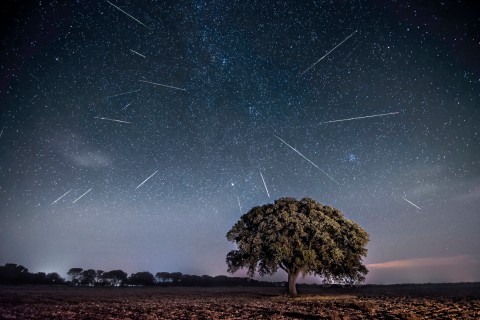Technology
How and when to view the best meteor shower of the year, the Perseids meteor shower, in 2022

Of all the meteor showers that take place throughout the year, the Perseids meteor shower is widely regarded as the most spectacular.
It’s when you’ll have the greatest chance of seeing a shooting star blaze across the night sky – no matter whereabouts in the UK you live.
The Perseids occurs each year as the Earth ploughs through dusty debris left by Comet Swift-Tuttle.
As the particles, ranging in size from a grain of sand to a pea, hit the Earth’s atmosphere at 37 miles per second, they burn up and streak across the sky.
In ideal conditions with no clouds, observers could see up to 150 an hour, according to the Royal Astronomical Society.
The meteor shower is often dubbed the best of the year because of how bright and active it is.
Here’s how to watch this highlight of the celestial calendar in the UK.
When does the 2022 Perseids meteor shower peak?
The Perseids meteor shower is active between mid-July and the end of August.
Which means you could head out tonight and have a good chance of spotting some meteors.
However, the shower is predicted to hit its peak on the night of Friday, 12th August and stretch into the early hours of Saturday, 13th August when the sky is at its darkest.
One of the most impressive meteor showers is happening this week!! 🌠
Up to 150 shooting stars can be seen every hour this week, with Saturday having the busiest sky
Darker skies will show more meteors, but this shower can still be seen in cities 🌃#Space #Meteor #STEM pic.twitter.com/MjfRgWrv2p
— STEM Response Team – University of Wolverhampton (@STEMResponseWLV) August 8, 2022
How to watch the Perseids meteor shower from the UK
You won’t need a telescope or binoculars to see the meteors – they can easily be seen with the naked eye.
The best way to catch a glimpse of the radiant show is away from the lights of towns, cities, buildings, and trees, and where there is a clear view of the horizon.
Although the meteors appear to emanate from the constellation of Perseus (which is how they got their name), they can appear anywhere in the sky, so try to find somewhere with the broadest view of the sky possible.
Observers have been advised to plan and check the forecast before in case the weather is unpleasant, so they can travel to a new location or go out on a different day.
Unfortunately, we’re due a full moon on 11th August so there will be a lot of extra moonlight to contend with during the peak.
Thankfully, the sparkling treat is set to continue over the northern hemisphere for a few days after the peak with reduced activity.
And if the weather doesn’t co-operate and visibility is poor, you can always watch a live stream of the shower via NASA Meteor watch Facebook.
Where does the Perseids meteor shower come from?
The Perseids are associated with Comet 109/P Swift-Tuttle, which last passed near Earth in 1992.

A Perseid meteor streaks across the sky during the annual shower
When comets travel close to the sun, they heat up and disintegrate. If this happens in Earth’s path around the sun, they can head towards our atmosphere at high speeds.
The superheated air around the meteors glows and leaves behind trails of light and explosions in the form of fireballs.

-

 Technology2 years ago
Technology2 years agoVoIP Number: Everything You Need To Know
-

 Music2 months ago
Music2 months ago[Music] Gnash Ft Olivia O’Brien – I Hate you, I Love you
-

 Music1 month ago
Music1 month ago[INSTRUMENTAL] John Legend – All Of Me
-

 Music2 months ago
Music2 months agoAlan Walker – Faded [INSTRUMENTAL]
-

 Music2 months ago
Music2 months ago[Video] 21 Savage ft. Offset & Metro Boomin – Rap Saved Me
-

 Music2 months ago
Music2 months ago[Instrumental] Wiz Khalifa – See You Again ft. Charlie Puth
-

 ANE Stories4 months ago
ANE Stories4 months ago[STORY] AMAKA THE LESBIAN (Complete Episodes)
-

 Music2 months ago
Music2 months ago[Music] Akon – Sorry Blame It On Me




































